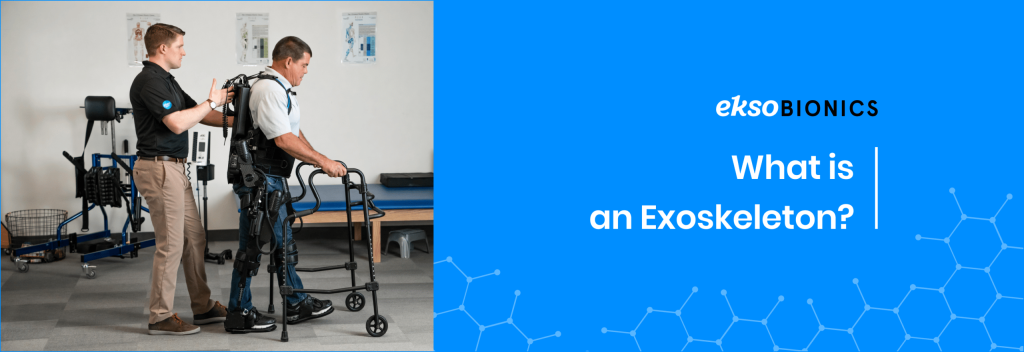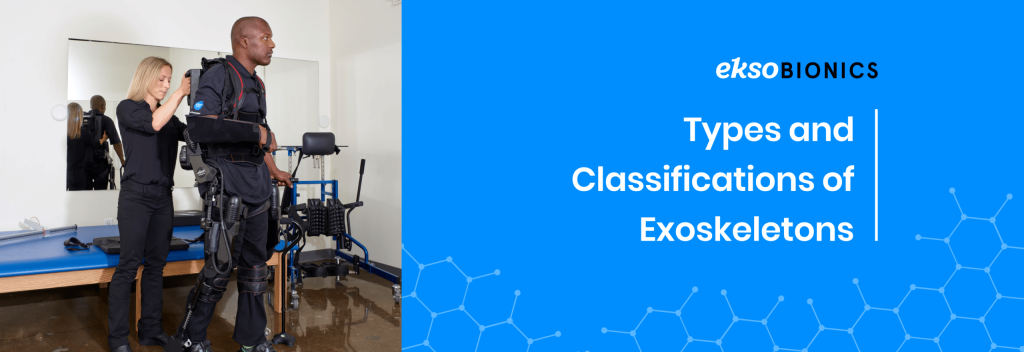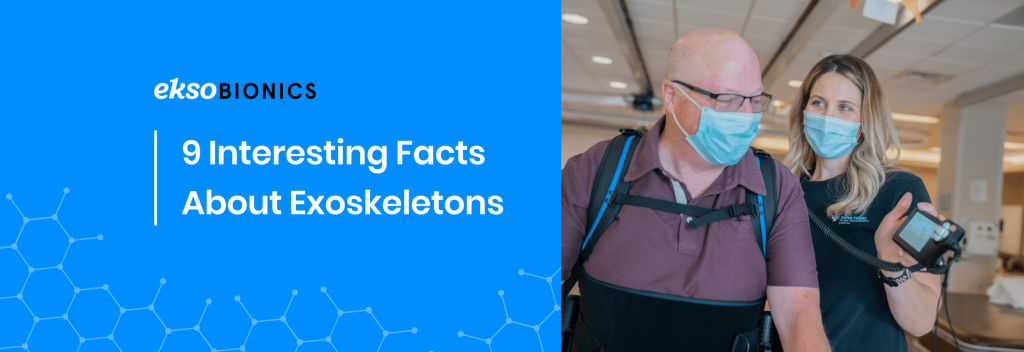Robotic exoskeletons are not a far-removed idea from our imagination, thanks to pop culture. Exoskeletons have been featured in films like Edge of Tomorrow [1], where Tom Cruise’s strength is augmented using a combat jacket [2], Marvel’s Iron Man [3], where Tony Stark’s abilities are amplified using AI and mechanics, and Avatar [4] where the AMP suit [5] is used to navigate Pandora. And now, they are no longer just part of science fiction but are a part of our reality. In 2014, Julian Pinto, who is completely paralyzed in his lower extremities, made history by kicking off the World Cup in Brazil with a robotic exoskeleton that was created by a team of more than 150 researchers. [6]
The robotic exoskeleton industry is experiencing a boom as more use cases are developed in new industries, and experts predict it will be worth $1.8 billion by 2025. [7] This article will cover everything you need to know about exoskeletons, including interesting little-known facts about exoskeletons.
What is an Exoskeleton?

An exoskeleton is a wearable device or a suit that works alongside the user to enhance their strength and amplify their performance. It is usually worn on the body. Exoskeletons use a combination of robotics and biomechatronics to enable body independence and are designed to provide support rather than replace functionality. In physical rehabilitation, they help patients relearn skills. In construction, they reduce the amount of energy expended and make repetitive tasks easier. And in the military, they are used to help soldiers carry heavier loads over longer distances.
The first exoskeleton-like device was invented by a Russian inventor known as Nicholas Yagn in 1890. It had a spring-operated design that was intended to be used by the military to run and jump, but it didn’t make it to production. However, that was just the beginning of what would later become a growing industry. In 1960 General Electric created a 1,500-pound exoskeleton called the Hardiman (Human Augmentation Research and Development Investigation). Unfortunately, it was too heavy and large, so the project was shelved. [8]
In 2000, engineers at UC Berkeley, backed by The Defense Advanced Research Projects Agency (DARPA), created a pair of robotic legs that were meant to reduce the energy used in carrying heavy loads over long distances. [9] Finally, there was a successful break into functional exoskeleton designs.
Today, robotic exoskeletons are more diversified and have undergone multiple iterations to create complex and advanced designs with various features and applications. For instance, Ekso Bionics creates exoskeletons used for neurorehabilitation, military research, and industrial uses.
Types and Classifications of Exoskeletons

There are different types and classifications of exoskeletons which depend on the body part where they are worn and how they are powered.
Exoskeleton Classification
- Full body – A full body exoskeleton is an exosuit that is used for strength augmentation in the military and rehabilitation.
- Upper extremity – An upper-extremity exoskeleton is one that supports the arms and potentially the torso. It can further be broken down into shoulder joints, elbow joints, the wrist, and even fingers.
- Lower extremity -This is an exoskeleton that is used to support the legs. It comes in different configurations like hip, knee, or ankle only, hip-knee, knee-ankle, or hip-knee-ankle.
Types of Exoskeletons
- Powered exoskeletons
These are exoskeletons that rely on batteries and electric cable connections to work. One great example of a powered exoskeleton is the EksoNR, which uses two sets of long-lasting, rechargeable lithium-ion batteries. Powered exoskeletons are divided into static and dynamic exoskeletons.
- Static exoskeletons: These exoskeletons require that the actuators be on at all times in order for the device to run well.
- Dynamic exoskeletons: Dynamic exoskeletons do not need actuators to be on, which makes them more energy efficient.
- Passive exoskeletons
These exoskeletons do not require electrical power in order to run. They rely on other mechanisms in order to work and are good for:
- Weight redistribution: The springs in the exoskeleton plus the locking action redirect an object’s weight into the ground.
- Energy capture: ankle spring-clutch exoskeletons may help improve walking efficiency.
- Dampening: Some exoskeletons are used as shock absorbers and vibration reducers.
- Locking: Some exoskeletons can be locked into place, which allows users to stay in one position for a long time.
- Pseudo-passive exoskeletons
These are exoskeletons that have all the features of a powered exoskeleton but do not provide actuation. E.g., the C-brace by Ottobock.
- Hybrid exoskeletons
These exoskeletons typically have all the features of a powered exoskeleton but use the input of the muscles as actuators.
9 Interesting Facts About Medical Exoskeletons and Other Exoskeletons

- Exoskeleton rehabilitation is one of the best ways for patients with mobility challenges to relearn walking.
Exoskeletons simulate natural gait during rehabilitation which initiates powerful brain signals that thanks to brain plasticity, can help patients recover their ability to walk. Exoskeletons also simulate natural gait by using drives in the hip and knee joints which move the wearer’s legs. Exoskeletons can be used by the patient independently or with the help of a therapist. They contain a predesigned program that helps therapists control the level of speed and power based on the patient’s needs. Exoskeletons can also be customized to an individual by adjusting the size.
- Training with exoskeletons positively influences a patient’s mental health.
Patients who train with exoskeletons report improved moods, morale, and mental health after just a few sessions. This can come from the ability to have conversations at eye level with other people. Exoskeletons also give hope to patients who were completely immobilized as they are able to walk again during training.
Standing in vertical positions also has benefits like better blood circulation and lung volume, which contribute to better overall health. Exoskeletons make the training more exciting as they are a far more advanced way of rehabilitation and tend to give patients confidence which can reduce depression and other mental health issues.
- Some exoskeleton models can be controlled by the patient’s thoughts.
This is not science fiction, we promise. You see, exoskeletons normally have different types of control systems like buttons, tablets, and smart crutches, which help the patient control the amount of support they receive from the exoskeleton. The most advanced control method in the world today is a brain activity interface that helps the patients actuate the exoskeleton using their thoughts. This allows for improved neural plasticity, which may contribute to the speed of recovery. “Hybrid Assistive Limb (HAL) works by using small sensors on the skin that detect minor electrical signals in a patient’s body,” explains Brooks Rehabilitation director of clinical technology Robert McIver, “As those signals are detected by the robot, it responds with a movement at the joint. It is the only system that I have come across where the patient’s nervous system acts on an external device.” [10]
Other exoskeletons like the EksoNR have touchscreen controls that help clinicians set goals and alter assistance levels for patients of all different functional levels. Physical therapists can also easily access the medical device’s database to analyze complex movement patterns and record patient progress.
- Some exoskeletons are made using the same materials as airplanes.
All exoskeletons use different materials in their build. The most common being carbon fiber and metal. Others are made from materials like steel alloys and aluminum which are heavy and rigid. All exoskeleton materials should be strong enough to support patients when in a vertical position.
- Exoskeletons are not exclusively for lower limbs.
Did you know that there are different types of exoskeletons? As highlighted above, exoskeletons are divided into full-body, upper-body, and lower-body exoskeletons. Exoskeletons can also cover a specific body part like the hip, knee, elbow, and even finger. Ekso Bionics is continually iterating exoskeleton designs to create more efficient and effective solutions.
- Exoskeletons are used in the medical, military, construction, and automotive industries.
There are two types of exoskeletons; medical exoskeletons and industrial exoskeletons. Medical exoskeletons are normally used in rehabilitation to help patients regain mobility, while industrial exoskeletons are used to augment human performance. Industrial exoskeletons are meant to make work easier for the wearer. You can read up on the use of exoskeletons in construction here.
Industrial exoskeletons were first developed in the 1900s when they were used in the military. They have since then found applications in construction, automotive, and agriculture. They are very mainstream, so much so they are considered a part of personal protective equipment (PPE) for some automobile companies like Ford.
- Exoskeletons were first featured in pop culture in 1919.
A lot of people tend to think that exoskeletons are a 21st-century idea, but in truth, it was existent even in the 20th century. Exoskeletons were first depicted in The Master Mystery, which is a 1918 American mystery silent film.
- Exoskeletons are used in sports.
Apart from medical and industrial applications, exoskeletons have found a new, fun application in the world of sports. As crazy as that sounds, Jonathan Tippett is pioneering an exoskeleton racing sport where racers control a 14 feet tall prosthesis and compete against other players. [11] The prosthesis relies on the leg, arm, hand, and feet movements of the user to move. It is powered by a lithium-ion battery and can run up to 20 mph. This sport is referred to as mechanical racing.
- You can use exoskeletons to be supersized.
Fancy having an exosuit that makes you ten times bigger than you already are? Now you can get one. Skeletonics create 10 feet tall exosuits that can turn you into a giant. Without the use of batteries or motors, all joints and limbs, including fingers, can move with precision mechanically. They utilize kinetic energy instead of electricity to power the exoskeletons. [12]
Conclusion

Just when you’ve learned everything there is to know about exoskeletons, a new exoskeleton is developed, or a new use case is created. That’s the beauty of being in the middle of a developing and fast-growing industry. At Ekso Bionics, we aim not just to be the leaders in exoskeleton technology but also to make exoskeletons that help patients regain full mobility.
We always aim to develop disruptive wearable robotics in the medical arena, and so far, we’ve helped thousands of patients with lower extremity disabilities take over 200 million Ekso-aided steps. We are at the forefront of shaping new devices for neurorehabilitation with FDA-cleared exoskeletons for MS, stroke, SCI, and other brain injuries. To learn more about Ekso Bionics, click here.
References:
- Edge of Tomorrow https://www.imdb.com/title/tt1631867/?ref_=nv_sr_1?ref_=nv_sr_1
- Combat Jacket https://allyouneediskill.fandom.com/wiki/Combat_Jacket
- Iron Man https://www.imdb.com/title/tt0371746/
- Avatar https://www.imdb.com/title/tt0499549/?ref_=nv_sr_2?ref_=nv_sr_2
- Amplified Mobility Platform https://james-camerons-avatar.fandom.com/wiki/Amplified_Mobility_Platform
- Paraplegic in robotic suit kicks off World Cup – BBC News https://www.bbc.com/news/science-environment-27812218
- ABI Research Predicts Robotic Exoskeleton Market to Expand at 39% CAGR and Reach $1.9 Billion in 2025 https://www.abiresearch.com/press/abi-research-predicts-robotic-exoskeleton-market-e/
- Exoskeletons History – part 3 https://www.mechatech.co.uk/journal/exoskeletons-history-part-3
- On the Mechanical Design of the Berkeley Lower Extremity Exoskeleton (BLEEX) https://bleex.me.berkeley.edu/wp-content/uploads/hel-media/Publication/On%20the%20Mechanical%20Design%20of%20the%20Berkeley%20Lower%20Extremity%20Exoskeleton%20-%20IROS05.pdf
- HAL: The Japanese cyborg medical exoskeleton helping US patients walk again https://www.medicaldevice-network.com/analysis/hal-japanese-cyborg-medical-exoskeleton-helping-us-patients-walk/
- World’s Largest Exoskeleton Racing Mech https://www.youtube.com/watch?v=euvMHPll23M
- Skeletonics https://www.skeletonics-us.com/